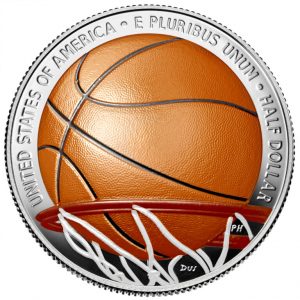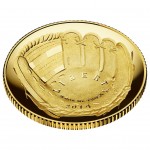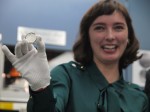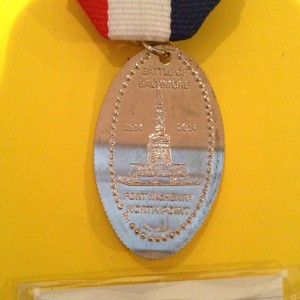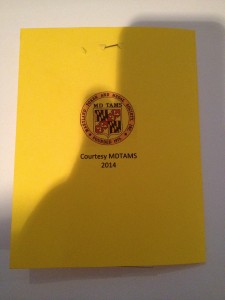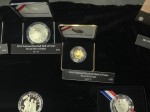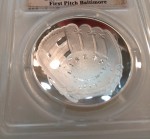Countdown to the Final Sales of 2020
Collectors of commemorative coins have until December 31 to purchase Women’s Suffrage Centennial Silver Dollars. They are available in proof and uncirculated finishes. Similarly, the Basketball Hall of Fame coins will also end next week. This program features a curved $5 gold coin, silver dollar, and clad half-dollar. It also means that the first colorized coins will also end.
Although I am not a collector of commemorative coins, I am a sports fan and enticed by the curved basketball coins. I ordered the Silver Dollar and the colorized clad half-dollar. I think the full-color half-dollar is better looking than just the colorized rim.
Following the 2018 American Innovation $1 Coin, the U.S. Mint began producing the coins as a reverse proof. The reverse proofs are enclosed in an individual folder with information about the coins and the innovation it honors. So that I can catch-up, I ordered the entire 2019 set. They have not released the South Carolina reverse proof coin honoring Septima Clark. When they do, I will order the complete 2020 set.
If you did not get what you wanted for the holidays or received gift cards, why not add something cool to your collection before the price doubles on the secondary market.
Numismatic Legislative Update
 Amongst all of the noise on Capitol Hill, the one area where no noise has been made is in the numismatic arena. For the last three months there has been no bill introduced, heard in committee, or acted on by either chamber of congress. Although there have been some hearings on a few issues, the last numismatic-related bill that had any congressional action was the introduction of the Pro Football Hall of Fame Commemorative Coin Act, S. 1842, introduced by Sen. Rob Portman (R-OH) in December.
Amongst all of the noise on Capitol Hill, the one area where no noise has been made is in the numismatic arena. For the last three months there has been no bill introduced, heard in committee, or acted on by either chamber of congress. Although there have been some hearings on a few issues, the last numismatic-related bill that had any congressional action was the introduction of the Pro Football Hall of Fame Commemorative Coin Act, S. 1842, introduced by Sen. Rob Portman (R-OH) in December.
This type of inactivity is unusual for congress. Regardless of party, congress is always looking to curry favor with their constituents and groups associated with their constituents by introducing commemorative coin legislation. Over the last few congresses (a two-year term), there will be over 40 coin-related bills that die in committee where very few even get a cursory hearing.
This does not mean there will be no commemorative coins in the near future. Now, the U.S. Mint has issued the Civil Rights Act of 1964 Silver Dollar and National Baseball Hall of Fame commemoratives. In fact, the Baseball Hall of Fame coins are so popular that the gold option has sold out of its 50,000 statutory mintage limit.
As an aside, a friend pointed out that the U.S. Mint did not bring 50,000 gold coins to the Whitman Baltimore Expo and wondered how many of those coins were purchased by baseball’s owners and members of the Baseball Hall of Fame. It would be interesting to see the effect of organized baseball on the sale of these coins.
In 2015, the U.S. Mint is scheduled to release a March of Dimes Commemorative Silver Dollar commemorative coin. Founded in 1938 by President Franklin D. Roosevelt to combat polio, the March of Dimes changed its mission to combating birth defects after the discovery of the polio vaccine by Dr. Jonas Salk in 1954. Salk’s work was supported by the organization.
Also on the schedule for 2015 is the United States Marshals Service 225th Anniversary commemorative coin series. The Marshal Service commemoratives will include a gold $5, silver dollar, and clad half-dollar coins. I do not think this will be as popular as the 2005 Marine Corps 30th Anniversary commemorative coins.
Officially, the 2016 scheduled commemorative will be the Mark Twain Commemorative coin program that will only include gold $5 and silver dollar coins. However, considering Twain’s mindset about being famous, I think he would be amused by having a commemorative coin made in his honor. I might call it the “Mark Twain Amusement commemorative.”
The only other commemorative coin with legislation that has passed congress and signed by the president is the 2017 Lions Clubs International Century of Service Silver Dollar.
Given the law says that there will be no more than two commemorative coin series per year (31 U.S.C. §5112(m)); and given that the next time only one commemorative coin is scheduled to be issues is in 2016, there is plenty of time for congress to do “something” and pass one of the bills that is currently waiting for their action.
Baseball gold is called out
It has been speculated that the U.S. Mint will strike more coins than the law (Public Law 108–291 [PDF]) allows on order from the Secretary of the Treasury. No official decision has been announced by either the U.S. Mint or the Department of the Treasury. However, it is questioned whether it is legal for the Secretary to make this decision unilaterally or requires an act of congress. There seems to be evidence that someone had previously approved an increase for the 2005 Marine Corps Commemorative dollar, but there is no authoritative source for proof.
Collectors who have contacted me are not happy with the U.S. Mint. Many believe that the high limit (50 coins per “household”) was too high. When I posted images of the graded baseball coins, several commented that they felt that dealers “abused” their access to the immediate supply of coins that were available in the U.S. Mint booth at the Whitman Baltimore Expo that many collectors did not have a fair chance.
None of my correspondents would bemoan a dealer’s ability to make money on the secondary market. But to do so by taking advantage of the U.S. Mint’s inability to manage its market as the lone producer of U.S. commemorative coins was considered excessive by many. Although I sympathized with their point of view since I could not purchase one for my collection, I questioned whether the U.S. Mint has an obligation to just sell the coins or satisfy market forces. But as many pointed out, the U.S. Mint is a government agency and has a responsibility to the people of the United States and not just the corporations.
While at the Whitman show I spoke with one of the U.S. Mint employees who said that they should have limited the number of coins someone can purchase at one time. Although they did enforce lower limits on the supply of coins sold on Saturday, the damage had been done leaving collectors to scramble to buy the coins on the secondary market or order them online. Those of us who order the coins from the U.S. Mint online catalog will have to wait until June 21, according to the notice sent to me. However, the website is saying that the proof dollar is backordered until July 7 while the clad proof half-dollar is will be available on April 10.
Like many of my correspondents, it is difficult to believe that anyone at the U.S. Mint would be afraid that this commemorative would not sell. A simple search using your favorite search engine would have shown that the coverage of the striking of the first curved coin in U.S. Mint history was seen world wide. Even the image of Cassie McFarland, the artist whose design was selected for the obverse of the coin, holding one of the first strikes in her gloved hand was reproduced on news outlets throughout the world. You cannot buy that kind of publicity.We are talking about baseball, America’s pastime. America’s game. Regardless of the accepted story of its founding, it is generally accepted that Major League Baseball was founded in 1869 making it the oldest organized league in North America. Not only was the coin released just before Opening Day for 2014, but the National Baseball Hall of Fame and Major League Baseball have been promoting this coin since the bill was signed.
To even hint that this was going to be a situation like the failure of the 2013 Girl Scout Commemorative would be very short sighted and foolish.
Maybe the U.S. Mint should review its sales processes than chase after pattern coins.
In the mean time, the U.S. Mint published a B-Roll for the National Baseball Hall of Fame Commemorative.
Image of Cassie McFarland courtesy of the San Francisco Examiner.
Neat find in Baltimore
As with every show I attend, I try to find something neat. Something a little different. Something to show you that you can enjoy collecting numismatics that do not have to be plugged into a blue folder, a brown album, or entombed in a plastic case by a grading service. These are great items that have meaning and, for the most part, are affordable.
My find from the Spring 2014 Whitman Baltimore Expo was not discovered while walking the bourse floor. It was an opportunity that came available during the board meeting for the Maryland State Numismatic Association. One of our Board members is Ed Craig who is also president of the Maryland Token and Medals Society. As part of the meeting, Ed showed a limited edition elongated quarter that Maryland TAMS produced to commemorate the 200th Anniversary of the Battle of Baltimore and the writing of the poem “The Defence of Fort McHenry” by Francis Scott Key.
For a reasonable price of $10, you get an elongated 2013 Fort McHenry Quarter with a design featuring the Baltimore Battle Monument on a ribbon to be worn on Defender’s Day. An elongated quarter in a flip is also included and both are attached to a card with a brief history of the Baltimore Battle Monument.When they rolled the quarter to create the design, it was imprinted on the obverse of the quarter. You can see the Fort McHenry quarter design through the flattened reverse.
I will be wearing the one I purchased this August at the World’s Fair of Money in Chicago.
Maryland TAMS is making a very limited number of these sets available for $10 each. If you cannot pick up your set, they will ask you to pay postage to mail it to you. If you are interested contact Maryland TAMS through their website at mdtams.org.
A swing and a…
With news coverage that covered almost every media outlet because of its unique curved design, the U.S. Mint invited Baltimore Orioles Hall of Famer Brooks Robinson to their booth at the Baltimore Convention Center on Thursday, March 27. Nothing gets the attention of the local Baltimore market more than bringing in a popular former Orioles player. Only Cal Ripkin, Jr. would have given them more attention and probably an even bigger draw.
By early Friday afternoon, when I was able to arrive to the show, the U.S. Mint was sold out of all options, including the uncirculated coins. With the plant manager of the Philadelphia mint present, he was able to order more coins to be delivered to the convention center for Saturday. But you had to be there early in order to purchase one of these coins. If you had to work and was not able to arrive to the convention center until later in the afternoon, like I did, you were out of luck.
On the bourse floor at Baltimore, there were a few dealers with an inventory graded versions of the coins. While I have no problems with dealers participating in the market and capitalizing on the coin’s apparent success, the U.S. Mint has to find a better balance between sales to the public and sales to the secondary market, especially for popular items. In other words, they did not learn from the 2013 Gold Buffalo reverse proof fiasco—or they do not want to learn since they have no competition.Resigned to the fact that the U.S. Mint once again failed to meet market demand, I ordered a proof dollar and half-dollar online. I also made sure my order was for more than $75 so that I can get one of the U.S. Mint reusable bags. I can use the bag to transport items to and from my coin club meetings.
The fact of the matter is that after last year’s failure of the Girl Scout commemorative coin to sell the minimum necessary for the Girl Scouts to benefit, it looks like the National Baseball Hall of Fame commemorative may be a home run. What would be a grand slam is that there were rumors on the bourse floor that the U.S. Mint was going to ask congress to update the law so that they can produce more coins. In the current law (Public Law 112–152 [PDF]), the U.S. Mint is limited to producing 50,000 $5 gold coins, 400,000 $1 silver coins, and 750,000 half-dollar clad coins.
If congress raises the mintage limits for the National Baseball Hall of Fame commemorative, it may be the first time they do so for any commemorative coin. Based on a search of online records with the Government Printing Office, there is no record of a modern commemorative coin (since 1982) having its mintage limits increase.
A sellout of these commemoratives would be good for the National Baseball Hall of Fame and Museum. According to the law, the National Baseball Hall of Fame would receive $35 for each gold coin sold, $10 for each silver dollar, and $5 for each half-dollar. If there is a sellout, the Hall of Fame stands to make $9.5 million. That would buy them over 63,000 dozen baseballs, 950,000 Louisville Sluggers made from ash, or more than 12,000 baseball fields using FieldTurf with some money left over for maintenance. Now that’s a lot of baseball!
Case Dismissed: eBay’s coin listing policy does not violate anti-trust laws
 The Ninth Circuit Court of Appeals upheld the dismissal of the antitrust class action suit against eBay for its policy for listing certified coins for sale.
The Ninth Circuit Court of Appeals upheld the dismissal of the antitrust class action suit against eBay for its policy for listing certified coins for sale.
The story begins in 2007 when eBay began to set standards for listing coins on its site. As part of its decision as to which coins could be listed as graded with their grade as part of the listing, the policy was created that grading services had to have been rated good or better in the 2006 Grading Services Survey performed by Professional Numismatic Guild and Industry Council for Tangible Assets.
After a lot of protest from the numismatic community, by 2008, eBay changed their policy for listing coins to require coins worth more than $2,500 to be graded and listings that mention grades be graded by an approved grading service. To become an approved grading service the company has had to grade 50,000 pre-1956 coins, provides an online population report, has three professional graders on staff with at least one a member of the Professional Numismatic Guild, provide a written guarantee, encase coins in a tamper resistant holder with anti-counterfeiting measures, and provide an online serial number verification service.
Initially, only coins graded by Numismatic Guarantee Corporation and Professional Coin Grading Service qualified under these rules. Shortly before the ruling was to take effect, ANACS and Independent Coin Graders make the necessary adjustments to have coins in their holders qualify for listing as graded on eBay.
Universal Grading Service (UGS) was a nascent New Jersey-based grading service decided to file an antitrust suit eBay, the American Numismatic Association, then ANA President Barry Stuppler, and PNG claiming that the rules are preventing them from competing in the market. Their claim was that coins in their holders were allegedly banned by eBay claiming that by using the study, eBay was in collusion with the ANA and PNG to prevent them from participating in the market, an alleged violation of the Sherman Antitrust Act.
UGS initially filed the anti-trust case in the Eastern District of New York. The court, based in Brooklyn, determined that since eBay was the lead defendant and the service most impacted by the suit, New York was not the proper jurisdiction. The court ordered that the case be transferred to Northern District of California.
The case was move to the San Jose Division for the Northern District of California and assigned to Judge Ronald M. Whyte. In mid-2011, Judge Whyte granted motions (with prejudice) to dismiss the case against the ANA, PNG, and Barry Stuppler. That left only eBay as the lone defendant.
On January 9, 2012, Judge Whyte granted eBay’s motion to dismiss the case with prejudice. Judge Whyte noted that the case was flawed from the beginning and gave UGS every opportunity over two years to amend the case in order to prove their claim. Judge Whyte agreed with eBay that USG did not provide evidence that eBay violated the Sherman Antitrust Act or other associated laws.
UGS appealed to the Ninth Circuit Court of Appeals saying that Judge Whyte wrongly dismissed the claim and that they met their filing responsibility under the Sherman Antitrust Act and associated state laws. The three judge panel affirmed the Judge Whyte ruled properly and let the dismissal stand.
UGS, who has ceased operations, can appeal the case to the full Ninth Circuit asking for a review. When appealing a ruling to a full circuit court panel, all nine judges assigned to that circuit, including the members of the three-judge appellate panel, will hear the appeal. An attorney familiar with Federal Circuit Courts said that it is rare that a dismissal by a federal district judge that is upheld by an appeals panel will be selected to be heard by the full circuit. He did note that stranger things have come out of the Ninth Circuit and it could be possible that they would hear the case.
After the Ninth Circuit, the next step would the Supreme Court. Sources report that if the full Ninth Circuit refuses to hear the case or the dismissal is upheld, “there is no attorney in his right mind” that would file an appeal to the Supreme Court after two courts uphold a dismissal.
With this ruling, the Universal Grading Service is effectively dead and buried. Whatever the people behind UGS were hoping to get out of this case will not be realized.
One thing this ruling says is that the cost to entry the coin grading market is very high. The court affirmed that eBay can set the market rules and as one of the dominating venues for selling coins, a new grading service would have to meet eBay’s requirements in order to gain market acceptance. The difficult benchmark is to have graded 50,000 pre-1956 coins.
There appears no reason why pre-1956 was picked as the dividing line. For many, it would make sense to select pre-1965 to include all coins that are pre-clad coinage. Calls to eBay to obtain clarification about the policy have not been returned. Since eBay consulted with John Albanese, principal of Numismatic Consumer Alliance and Certified Acceptance Corporation (CAC), contacting him may be an option.
Interestingly, if eBay is to follow its policy to the letter, coins that received verification stickers from the CAC cannot be listed as part of the grade. Titles should not be allowed to indicate that the coins have been verified by CAC nor should the description. As far as I am concerned it would be acceptable for eBay to ban the designation of CAC verification as I am not a fan of the service.
Which raises a thought: considering the CAC’s business model includes only coins certified by NGC and PCGS, and given Albanese’s past associations with both of those services, if the case was limited to eBay and Albanese/CAC would it have been more successful?
